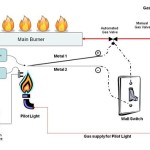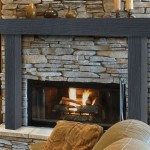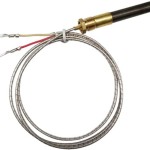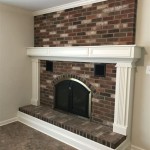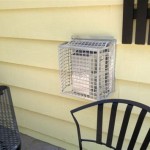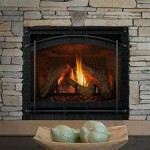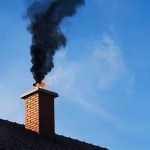Mounting a TV on a Stone Fireplace: A Comprehensive Guide
Mounting a television above a fireplace, particularly one constructed of stone, presents a unique set of challenges compared to mounting on drywall or wood framing. The inherent density and irregular surface of stone require careful planning, specialized tools, and a thorough understanding of the potential issues involved. This article provides a detailed guide to navigating the process, ensuring a secure and aesthetically pleasing installation.
Before undertaking this project, it is crucial to assess the feasibility and potential drawbacks. The primary concern is heat exposure. TVs are electronic devices sensitive to high temperatures. Prolonged exposure to heat radiating from a fireplace can damage the internal components, shorten the lifespan of the TV, and potentially void the manufacturer's warranty. Consider the frequency and intensity of fireplace use. If the fireplace is used regularly and generates significant heat, an alternative location for the TV might be more prudent.
Another key consideration is viewing angle. Mounting a TV high above a fireplace often necessitates tilting the screen downwards for optimal viewing. While adjustable mounts can accommodate this, an excessively high viewing angle can lead to neck strain and discomfort, especially during extended viewing sessions. Evaluate the typical viewing position and desired screen size to determine the ideal mounting height. Mocking up the screen size with cardboard can help visualize the final result before committing to the installation.
Aesthetic considerations also play a significant role. The visual impact of a large television dominating a fireplace mantel can be debated. Consider the architectural style of the room and the overall design aesthetic. Concealing cables and wires is essential for a clean, professional look. This may involve routing cables through the stone or utilizing cable management solutions to minimize visual clutter.
Assessing the Stone Fireplace for Mounting
The type of stone used in the fireplace construction is a critical factor in determining the appropriate mounting method and hardware. Natural stone, such as granite, marble, or slate, is generally dense and strong, offering a stable surface for mounting. However, these materials can be brittle and prone to cracking if drilled improperly. Cultured stone, a manufactured product designed to mimic the appearance of natural stone, is often less dense and may require specialized anchoring techniques.
The thickness and consistency of the stone are also important considerations. Thicker stone provides greater support and allows for deeper anchor placement. Variations in thickness or the presence of voids behind the stone can compromise the stability of the mounting system. It is advisable to consult with a professional structural engineer or contractor to assess the structural integrity of the stone fireplace, especially if the TV is large or heavy.
Carefully inspect the mortar joints between the stones. The mortar may be weaker than the stone itself and may not provide sufficient holding power for mounting hardware. Avoid drilling directly into the mortar joints whenever possible. Instead, focus on anchoring into the solid stone itself. Test the solidity of the mortar by gently probing it with a small awl or screwdriver. If the mortar crumbles easily, it is unlikely to provide a secure anchor point.
The presence of a mantel can also affect the mounting process. A mantel can provide some degree of heat shielding for the TV. However, it can also obstruct the viewing angle and limit the available mounting space. The mantel's depth and construction must be considered when selecting the appropriate mounting bracket and hardware. It may be necessary to extend the mounting bracket beyond the mantel to achieve the desired viewing angle.
Selecting the Appropriate Mounting Hardware and Tools
Choosing the right mounting hardware is paramount for a secure and safe installation. A full-motion mount, which allows for tilting, swiveling, and extending the TV, offers the greatest flexibility in adjusting the viewing angle. However, these mounts are typically larger and heavier than fixed or tilting mounts, requiring stronger anchors and a more robust mounting surface. A tilting mount provides a simple way to adjust the vertical viewing angle, while a fixed mount holds the TV flush against the wall.
The weight capacity of the mounting bracket must be greater than the weight of the TV. Consult the manufacturer's specifications for both the TV and the mounting bracket to ensure compatibility and adequate load-bearing capacity. Consider a bracket with a safety factor of at least 25% above the TV's weight to provide an extra margin of safety.
Selecting the appropriate anchors for stone is critical. Concrete screws, sleeve anchors, and wedge anchors are commonly used for mounting into solid stone. Concrete screws are relatively easy to install and provide good holding power in dense stone. Sleeve anchors offer greater holding power and are suitable for heavier TVs. Wedge anchors are designed for heavy-duty applications and provide the strongest possible hold. Always follow the manufacturer's instructions for installing the anchors, including the recommended drill bit size and torque specifications.
Specialized tools are essential for drilling into stone without causing damage. A rotary hammer drill with carbide-tipped drill bits is required. A standard drill will not be effective and may damage the stone or the drill bit. Use a variety of drill bit sizes, starting with a small pilot hole and gradually increasing the size to the desired diameter. This helps prevent chipping and cracking the stone. A level is essential for ensuring that the TV is mounted straight. A stud finder is not relevant in this scenario. Cable management tools, such as wire strippers, crimpers, and cable ties, are needed for concealing and organizing the cables.
The Mounting Process: Step-by-Step Guide
Safety is paramount. Always wear safety glasses and a dust mask when drilling into stone. Disconnect the power to the fireplace before beginning the installation process. Have an assistant available to help lift and position the TV.
Begin by carefully planning the location of the mounting bracket. Use a level and measuring tape to ensure that the bracket is centered and aligned correctly. Mark the locations of the anchor holes on the stone. Use a pencil or marker that is easily visible on the stone surface.
Drill pilot holes at the marked locations. Use a small-diameter carbide-tipped drill bit and a rotary hammer drill. Apply gentle pressure and allow the drill to do the work. Avoid forcing the drill, as this can damage the stone. Gradually increase the drill bit size to the recommended diameter for the chosen anchors.
Install the anchors according to the manufacturer's instructions. Insert the anchors into the drilled holes and tighten them securely. Ensure that the anchors are flush with the stone surface and that they are providing a solid grip.
Attach the mounting bracket to the anchors. Use the appropriate screws or bolts to secure the bracket to the anchors. Tighten the screws or bolts securely, but avoid over-tightening, which can damage the anchors or the stone.
Mount the TV to the bracket. Follow the manufacturer's instructions for attaching the TV to the bracket. Ensure that the TV is securely attached and that it is level. Adjust the tilt and swivel of the TV to achieve the desired viewing angle.
Conceal the cables and wires. Route the cables through the wall or use cable management solutions to minimize visual clutter. Secure the cables with cable ties or clips. Consider using a cable concealer to hide the cables completely.
Test the installation. Turn on the TV and ensure that it is functioning properly. Check the viewing angle and make any necessary adjustments. Inspect the mounting hardware to ensure that everything is secure. Observe the TV during fireplace use to monitor heat exposure and make adjustments as needed.
Professional installation is recommended if you are uncomfortable with any aspect of the mounting process or if you have concerns about the structural integrity of the stone fireplace. A professional installer has the experience, tools, and expertise to ensure a safe and secure installation.

Mounting A Tv Above Fireplace With Full Tutorial Fixthisbuildthat

Smarthome And Theater Systems Residential Solutions Photo Album Tv Mount Over Stone Fireplace In New Canaan Ct

Mounting A Tv Above Fireplace With Full Tutorial Fixthisbuildthat

Mounting A Tv Above Fireplace With Full Tutorial Fixthisbuildthat

The Ultimate Guide To Mounting Your Tv Over Fireplace 4 Easy Steps Patriot Chimney

Mounting Tv Over Stone Fireplace Kouland Technology Inc

Made How To Mount A Flat Screen Tv On Stone Fireplace Diy

Natural Stone Fireplaces With Wall Mount Television Design Ideas

Hanging A Tv On Rock Wall

Mounting A Tv Above Fireplace With Full Tutorial Fixthisbuildthat
Related Posts

